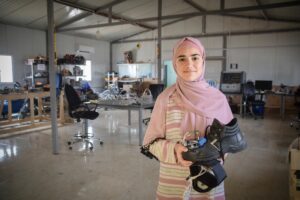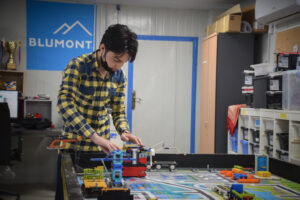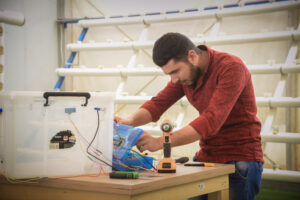“I wanted to make something that can help people in the camp and all over the world,” said Rania, a 16-year-old Syrian refugee living in Za’atari refugee camp in Jordan.
Rania, who is a regular participant at the Innovation Lab in the camp, created a prototype for a shoe with sensors in the soles. The shoes alert visually impaired individuals when the sensors detect obstacles that may hinder their movement or jeopardize their safety.

Rania designed shoes for the visually impaired that have specialized soles that detect obstacles.
The Innovation Lab is a safe space at Za’atari Camp where young people can channel their energy and creativity to benefit the community. Participants create prototypes and build devices to address challenges and find solutions to everyday problems through technology. The lab’s trainers and counselors are camp residents with subject matter expertise who teach coding and robotics through hands-on workshops.
Through the UNHCR-funded Community Based Protection project, our teams work to engage refugees at Za’atari and create opportunities through a variety of activities and community-centered programs.
Rania has been participating in the Innovation Lab activities for two and a half years. While she has taken 3D printing, programming, and robotics courses, her true passion is learning about the possibilities of artificial intelligence.
“When I come here, I get to learn about new things, and develop my skills,” said Rania. “I want to keep inventing, creating, and finding ways to give back to my community and make a difference.”
Rania encourages other girls to learn about programming, and advocates for their presence in technology. “Girls have to work hard and prove that they can do anything. There is nothing that a boy can do that a girl can’t. We are all equal.”

For Ahmad, the Innovation Lab is a place to learn and socialize outside of school.
Ahmad, another teenager living in the camp, has been attending sessions at the Innovation Lab for the past year.
“I feel happy and ecstatic when I come here. I used to watch videos about programming, but I never had the chance to learn,” he said.
Lately, he has been focused on creating robots and participating in robotics tournaments. While he has seen the benefits of his new skills in his performance at school, he has also noticed that he feels more engaged overall. “I used to go home directly from school, and I was isolated. Now I have new friends, I can socialize, and I feel better.”
The different courses provided at the Innovation Lab equip participants with the tools to learn real life skills that can be applied to create sustainable change and development in the camp, while supporting social and educational advancement.
“Everything I learn here will help me at school and it will open doors for me in the future – to find a job and study at university,” Ahmad said.

Husam’s invention could help camp residents grow plants year-round in their homes.
Husam, 23, is another aspiring inventor who frequents the Innovation Lab. “I was curious about new agricultural methods,” He said. “We need a better method to grow plants in the camp, and I wanted to learn how to do that.”
Working with the Innovation Lab team, Husam built a grow box—an enclosed system for growing plants indoors or in small spaces. Husam wanted to utilize technology and skills that he learned at the lab to “create a right environment for cultivating plants that can grow under the harsh weather conditions of the camp, all year round.”
With his community in mind, Husam is innovating to improve the daily lives of those around him. One day, with Husam’s ingenuity, there could be plants growing in every home at the camp.



